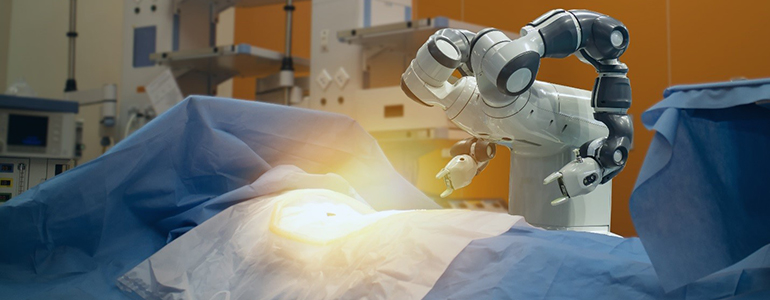Medical Robots and Robotic Devices

18 Jun 2019
Ensuring Compliance with Regulatory Requirements and New Standards
A high potential for robotics in the healthcare industry could lead to a dramatic change in the sector in the coming years. The use of robotic devices in medical applications and setting started years ago with robotic-assisted surgery and has evolved to include applications in vascular, endoscopic, or orthopedic surgery; assistance for interventions and diagnostics; rehabilitation; and personal assistants. The global market for surgical robots along is expected to nearly triple in less than a decade, from $4.5 billion in 2016 to $12.6 billion in 2025.1
Manufacturers of medical robots must be aware of multiple standards and technical reports that apply to these products:
- ISO 14971 and IEC 60601 series: Apply to robots used as medical electrical equipment or systems. These standards provide methodologies on addressing risk management and requirements for basic safety and essential performance.
- IEC 80601-2-77: Specific to medical robots, this standard includes particular requirements for basic safety and essential performance of robots used for surgery assistance.
- IEC 80601-2-78: A standard specific to robots used for rehabilitation, assessment, compensation or alleviation, covering their basic safety and essential performance.
- IEC TR 60601-4-1: Gives guidance on medical electrical equipment and systems employing a degree of autonomy
Looking beyond the above documents by taking into consideration safety related requirements from standards used in other industries such as for robots used for industrial applications or personal care, and functional safety, will help manufacturers to make key decisions having an impact on the design of the medical robot, and to demonstrate compliance with regulatory requirements in the targeted countries.
Innovation in robotic technology and an ever-changing healthcare landscape are coming together to pave the way for medical robots and robotic devices to become more prevalent in the industry. As standards emerge and evolve to ensure the safety and performance of these cutting-edge products, it is important to be aware of the requirements and to partner with a trusted third party to help meet the requirements and ensure compliance. Learn more about the requirements for medical robots, testing and certification options in our complimentary fact sheet.
Source:
- Statista. Global market size for surgical robots in 2016, 2017, and a forecast for 2025 (in billion U.S. dollars). https://www.statista.com/statistics/877720/surgical-robots-market-value-worldwide/. Accessed 5/7/19

Claudia Sirch
Regional Chief Engineer (EMEA);
Chief Engineer, Medical
Claudia Sirch is the global chief engineer for medical, laboratory, measurement and control equipment and laser products at Intertek. She has over 25 years of experience in the testing and certification business, and is a lead and technical assessor in the IECEE CB Scheme. She holds a Bachelor of Science in Engineering Physics from Munich University of Applied Sciences.